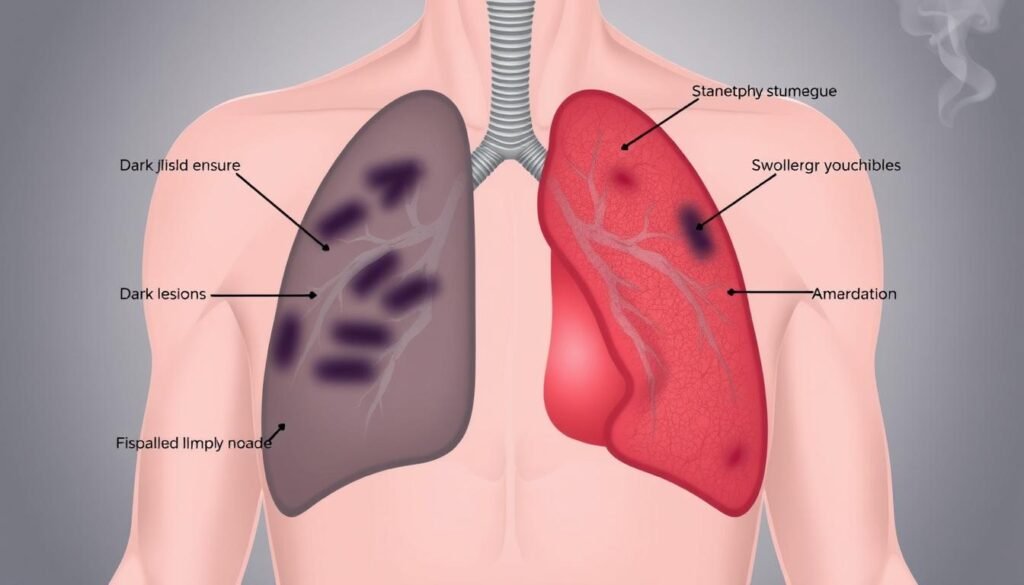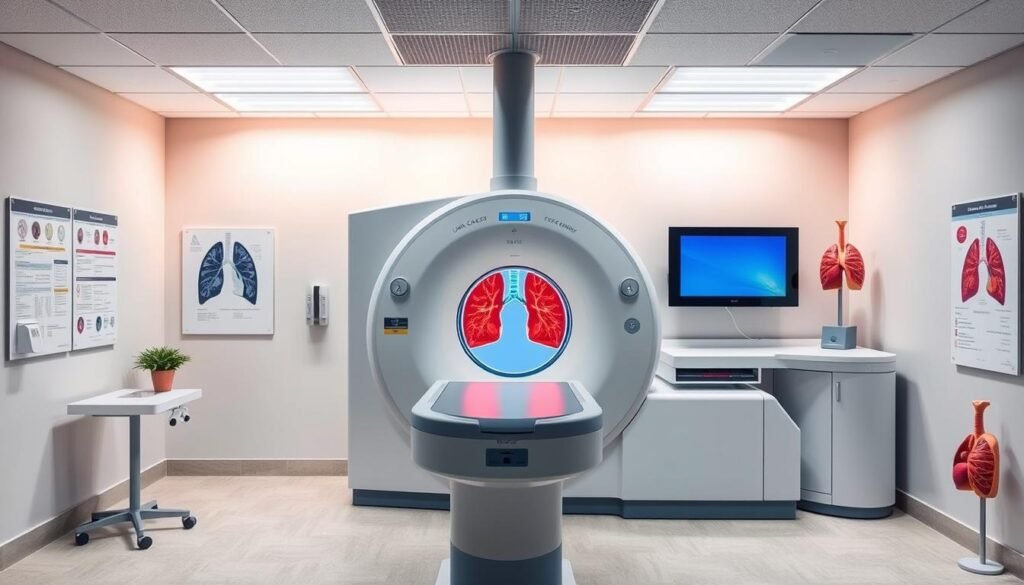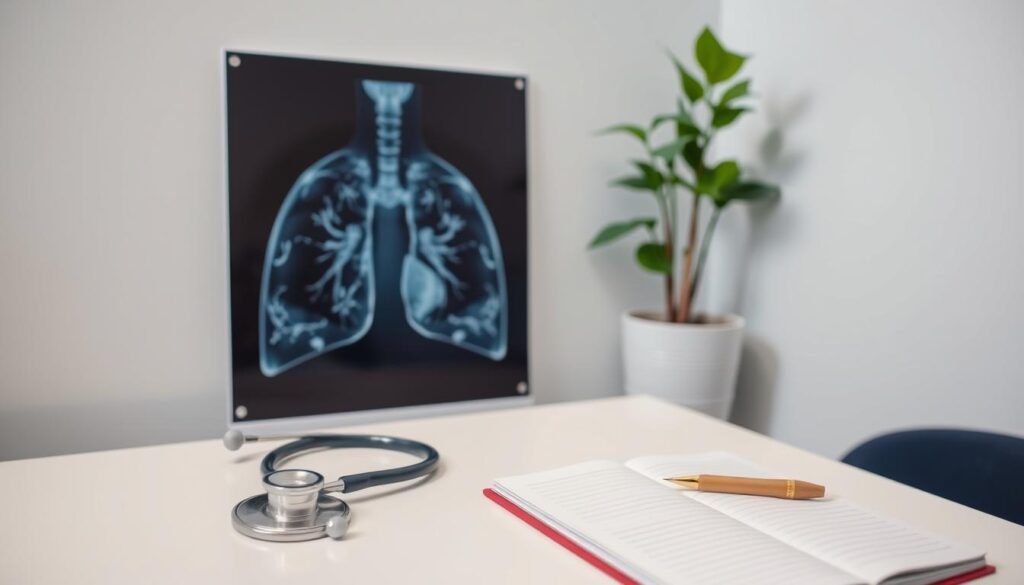Did you know that lung cancer ranks as the second most common cancer in the United States? It is also the top cause of cancer-related deaths. Many people do not notice any lung cancer symptoms until the cancer is advanced. This fact makes knowing about early detection very important. Spotting the lung cancer warning signs early can hugely affect treatment choices and results. Seeing a healthcare provider early on, when symptoms appear, can help catch the disease sooner. This early catch can make treatments work better.
Learning about symptoms like a long-lasting cough, pain in the chest, or losing weight without trying is key. Don’t overlook these warning signs. Lung cancer screening, such as scans with low doses of CT, can truly be lifesaving. Knowing what signs to watch for gives people the power to act early for their health.
Key Takeaways
- Early detection of lung cancer increases treatment effectiveness.
- Common symptoms include persistent cough, chest pain, and unexplained weight loss.
- Lung cancer screening, particularly with low-dose CT, can save lives.
- A doctor’s visit for concerning symptoms is crucial for timely diagnosis.
- Awareness of lung cancer warning signs can lead to better outcomes.
- Smoking cessation is vital for prevention and risk reduction.
Understanding Lung Cancer
Lung cancer leads to the most cancer deaths worldwide. It has two main kinds: non-small cell and small cell lung cancer. Knowing these types helps identify risks and treatments.
Non-small cell lung cancer (NSCLC) makes up about 85% of all cases. It grows slower than other types, giving doctors more time to find and treat it. Small cell lung cancer (SCLC), however, grows quickly and is often caused by smoking.
The type of lung cancer matters a lot for treatment and prognosis. Being aware of the differences helps people manage their health better. Screening for lung cancer is recommended for those 50 and older with a heavy smoking past or those who have recently quit.
Lung cancer stages go from 1 to 4. The lower the stage, the earlier the cancer. Small cell lung cancer is described as limited or extensive, depending on its spread.
Understanding lung cancer types and stages is crucial for at-risk individuals. This knowledge is key for early detection and getting the right treatment. It ensures patients get the care best suited to their situation.
Why Early Detection of Lung Cancer Matters
Finding lung cancer early is key to getting better treatment. If caught early, people have a higher chance of surviving. They can get surgery, chemo, and radiation that really work.
Research shows how vital early detection is. For example, the National Lung Screening Trial (NLST) found that screenings with low-dose CT (LDCT) cut death rates by 20% among those screened. Most of the lung cancers found early, about 63%, were at stage I. This shows the big benefits of catching it early.
On the other hand, late-stage lung cancer has a poor outlook. If caught at stage I, the 5-year survival rate might be over 90%. But at stage IV, the survival rates drop to less than 10%. This stark difference underlines the importance of early detection.
- Benefits of Early Detection:
- Increased survival rates for early-stage patients.
- Access to more effective treatment options.
- Reduced overall mortality rates in high-risk populations.
Additionally, pairing early detection with regular screenings boosts survival rates. It also greatly enhances the quality of life for patients. As technology and awareness improve, it becomes more important to stay informed and proactive about our health.
Common Symptoms of Lung Cancer
Lung cancer has signs that might seem minor at first. It’s vital to catch these early for better treatment chances. Symptoms include a cough that gets worse, chest pain that hurts more when breathing deeply, and shortness of breath during common tasks. Also, watch for wheezing and a rough voice as they can mean blocked airways or nerve issues. If you notice these, see a doctor to check if it’s lung cancer or something else.
Persistent Cough
If you’ve had a cough for over eight weeks, it could be lung cancer. This persistent cough might get so bad that it causes you to cough up blood. This is serious and needs immediate doctor’s attention. Sometimes, this cough seems like just a cold or bronchitis, which makes people wait too long to get help.
Chest Pain
Sometimes, lung cancer shows up as chest pain. This pain happens when you cough, take deep breaths, or laugh. If the pain stays and messes with your day, it might be lung cancer. It’s key to not ignore this and see a doctor right away.
Shortness of Breath
Struggling to breathe or getting winded easily might mean lung cancer. This happens when airways get narrow, really affecting your life. Don’t wait if breathing gets tough; get checked by a doctor.
Wheezing and Hoarseness
Wheezing can be a lung cancer sign when airways are blocked. A hoarse voice might come from too much coughing or a tumor on the vocal cords. If you have these signs with others linked to lung cancer, it’s important to talk to a doctor to find out why.
Knowing these common symptoms of lung cancer helps catch it early. Early detection can make treatment more effective and increase survival chances.
Advanced Symptoms of Lung Cancer
When lung cancer gets worse, the signs become clearer and affect many parts of the body. Knowing these signs early is key for getting help quickly. It also helps doctors decide the best way to treat it.
Bone Pain and Neurological Symptoms
If lung cancer spreads, you might feel a lot of pain in your bones. This pain happens because the cancer has moved to the bones, making it hard to move without hurting. If you start having headaches or feel weak in your arms or legs, it could mean the cancer has reached your brain or spine. These serious signs mean you should see a doctor right away.
Jaundice and Lumps in the Neck
In late stages, lung cancer might cause jaundice, which turns your skin and eyes yellow. This usually means the liver is affected by the cancer. Also, you might find lumps in your neck. These lumps are often swollen lymph nodes that show the cancer is spreading. Spotting these symptoms is important for talking about what comes next and the treatments available.

| Symptom | Description |
|---|---|
| Bone Pain | Discomfort resulting from cancer spreading to the bones. |
| Neurological Symptoms | Includes headaches and limb weakness, indicating brain involvement. |
| Jaundice | Yellowing of skin and eyes, often due to liver involvement. |
| Lumps in the Neck | Enlarged lymph nodes due to cancer spread. |
Risk Factors for Lung Cancer
Lung cancer development is driven by risk factors for lung cancer that fall into two groups. One group includes things you can change, and the other includes those you cannot. Lifestyle choices and where you live or work play a big part in this.
Smoking and Secondhand Smoke
Smoking is the top cause, linked to about 90 percent of lung cancer cases. This risk comes from smoking yourself or being around someone else’s smoke. Secondhand smoke is just as dangerous, raising lung cancer risk by 20-30% for non-smokers around it often.
Exposure to Radon and Asbestos
After smoking, radon exposure is the next big lung cancer cause in the U.S. It causes about 30 percent of lung cancer deaths in non-smokers. Radon, a radioactive gas, can build up in homes and buildings. Being around asbestos, especially at work, also risks lung cancer. Almost 70-80 percent of mesothelioma cancer cases are due to asbestos.
Family History and Genetic Factors
Your family history matters a lot in assessing lung cancer risk. Having relatives with lung cancer doubles your own risk. With two or more affected first-degree relatives, your chances go up even more. Genetics and environment together increase lung cancer risk.
It’s crucial to know and address these risk factors for lung cancer for prevention. For deeper insights, visit risk factors and prevention.
Lung Cancer Screening Methods
Early detection of lung cancer improves treatment success. It’s vital for catching the disease early. Regular check-ups help spot lung cancer signs. They also identify who might be at risk. Screenings are key for those at high risk.
Importance of Regular Check-ups
The importance of health check-ups cannot be understated. They are crucial for people 50 to 80 years old with a heavy smoking past. At least 20 pack-years of smoking is significant. Early screening can save lives. If you quit smoking in the last 15 years, get checked often.
Low-Dose CT Scan: A Game Changer
The low-dose CT scan is a major advancement. It’s backed by the US Preventive Services Task Force. The scan is easy and pain-free. It detects lung changes early on. This has helped lower death rates in those at risk.

Low-dose CT scans have great benefits, but be mindful of risks. False positives and radiation are concerns. Annual screenings aren’t advised after turning 81 or quitting smoking for 15 years. Most health plans cover the screening for those eligible.
To learn about lung cancer signs, check out this guide. Screenings give vital health information. They help catch issues early, offering the best chance at good health.
| Criteria for Lung Cancer Screening | Details |
|---|---|
| Age Range | 50 to 80 years |
| Smoking History | 20 pack-years or more |
| Smoking Status | Current or quit within the last 15 years |
| Screening Termination | Aged 81 or no smoking for 15 years |
| Screening Method | Low-dose CT scan |
| Coverage | Insurance typically covers screening for eligible individuals |
Biomarkers for Lung Cancer
Biomarkers are key in diagnosing and treating lung cancer. They are found in blood, tissue, and other fluids. They show if lung cancer is present and what type it is. Genetic markers are very important too. They help decide the best treatment for each patient. By knowing specific mutations in lung cancer, doctors can provide personalized care. This improves the chances of success with targeted therapies.
Biomarkers help make lung cancer diagnostics more accurate. Researchers have found many biomarkers. They’ve made tests that look for certain microRNAs, lipids, and metabolites. These tests are good at finding lung cancer. The value of these biomarkers in clinics is still being studied. Scientists are working hard to bring their discoveries to patients.
The role of biomarker testing in lung cancer is huge. It helps find the disease early and pick the right treatment. This is key in cancer care today. You can find more info on biomarkers and lung cancer here.
| Biomarker Type | Examples | Targeted Therapies | Immunotherapy |
|---|---|---|---|
| Genetic Markers | ALK, BRAF V600E, EGFR | PD-L1 Protein | Available for NSCLC |
| Non-Genetic Biomarkers | Circulating microRNAs, lipids | N/A | Ongoing research |
| Driver Mutations | KRAS G12C, MET exon 14 | Targeted therapy drugs | N/A |
| Molecular Signatures | Nasal swabs detection | N/A | Potential for early detection |
Non-Invasive Diagnostics in Lung Cancer
Lung cancer is the top cause of cancer deaths worldwide. Every year, about 2.21 million new cases and 1.8 million deaths are reported. This shows a pressing need for effective lung cancer testing. Recently, developments in detecting lung cancer have emphasized the importance of non-invasive diagnostics. Liquid biopsies stand out by identifying lung cancer with minimal discomfort to patients.
Liquid biopsies test for cancer DNA in blood samples. This modern option is different from traditional, painful surgeries. These tests offer crucial details about the presence of cancer, its genetic changes, and how well treatment is working. Non-invasive diagnostics help doctors quickly start treatment, which is key to saving lives. Right now, the 5-year survival rate for lung cancer is only 20%. But, catching it early can greatly boost survival chances, especially for those found at stage 1A. Their survival rates can jump to over 90% in ten years.
Non-invasive tests are vital for patient comfort and effective lung cancer testing. Studies reveal that specific DNA changes in sputum samples can show early lung cancer. These changes, called DNA methylation, are linked with lung tumors. This discovery highlights the value of using certain markers for early disease detection.
| Diagnostic Method | Invasiveness | Patient Comfort | Effectiveness in Early Detection |
|---|---|---|---|
| Liquid Biopsy | Non-invasive | High | Promising |
| Low-Dose CT Scan | Minimally invasive | Moderate | Effective |
| Surgical Biopsy | Invasive | Low | High |
As non-invasive diagnostics improve, they could greatly affect lung cancer survival rates. Adopting these methods widely could better detection and patient care overall. For deeper understanding, check out this detailed study on the topic.
Smoking Cessation and Lung Cancer Prevention
Stopping smoking is key in lowering lung cancer risk. About 85% of lung cancer cases are linked to tobacco. Quitting smoking can greatly improve your health and life quality. Many strategies exist to help people stop smoking and live healthier.
Tips for Quitting Smoking
To quit smoking, you need to combine different methods. Here are some useful tips:
- Make a quit plan with goals and deadlines.
- Get support from friends, family, or groups. This encouragement helps a lot.
- Try nicotine replacements like patches or gum to control cravings.
- Use counseling to tackle the mental side of addiction.
- Stay active and eat healthily to boost your well-being.
These tips for quitting smoking help beat addiction and prevent lung cancer. Support and smart strategies raise success rates, leading to healthier lives.
| Benefits of Quitting Smoking | Impact on Lung Cancer |
|---|---|
| Improved survival rates after a lung cancer diagnosis | Higher chances of living longer compared to those who continue smoking |
| Reduced risk of recurrence of cancer | Lower incidence of second primary malignancies |
| Enhanced quality of life | Less symptom burden and improved health outcomes |
Using strong smoking cessation methods lays the groundwork for better lung cancer prevention. It leads to healthier individuals and communities.
Early Intervention Strategies
Looking into early intervention for lung cancer shows big benefits for patients. Finding it early means doctors can use treatment strategies that change a patient’s future. Catching lung cancer early can help people live longer and better lives.
How Early Detection Affects Treatment Options
Recognizing early detection’s value is key to fighting cancer. People caught early can often have surgery to remove tumors, aiming for a full recovery. They might also get targeted therapy, attacking cancer more gently than later-stage treatments.
But, finding lung cancer late often limits the choices. Late-stage patients may need care that focuses more on comfort than cure. Statistics show early treatment means more than 80% of patients might survive, while late detection leads to survival rates below 10%.
The table below shows how survival rates differ with the stage of lung cancer:
| Stage of Lung Cancer | 5-Year Survival Rate | Typical Treatment Options |
|---|---|---|
| Stage IA | Over 75% | Surgery, targeted therapy |
| Stage IV | Less than 10% | Palliative care |
Raising awareness about the early signs and screening often can lead to better results. Top clinics like the Lung Cancer Early Detection and Prevention Clinic use the latest tests to help those at high risk. This effort is crucial for better survival rates and progress in treating lung cancer.

Conclusion
Finding lung cancer early is very important. In the U.S., someone finds out they have it every two minutes. Knowing the early signs and risks is key to fighting this disease. Every day, 361 patients die from it. But catching it early through tests can really help improve survival rates.
Surprisingly, only 16.0% of people who should get checked for lung cancer did so in 2022. Getting checked regularly can cut the death rate by up to 20%. So far, screenings have added 80,000 years to people’s lives. If everyone who should get screened did, we could save an extra 500,000 years of life in the U.S.
In the last five years, the survival rate for lung cancer went up by 26%. This is thanks to new screening methods like low-dose computed tomography (LDCT). It shows how important it is for people to join in screenings and live healthier. By spreading the word about lung health, we can help more people catch cancer early. This will help improve their chances of surviving and living better lives.